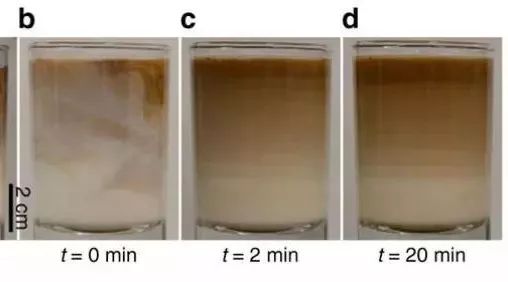
As long as you fall down gently, you get a beautiful layering?
in the following picture, a small cup of hot espresso is poured into a cup of heated milk. At first, their mix seemed quite chaotic. However, after waiting for a while, something magical happened: a neat layering appeared in the glass.
Bob Fankhauser, a retired engineer, inadvertently made this kind of tidy and layered coffee at home. He wondered: how on earth did these layering come about?
it is not easy to make a beautiful stratification of two liquids that are miscible with each other and have no much difference in density. It is indeed unusual for the step of making a layered latte to simply pour it in.
(from chaos to neat layering)
with his question, the veteran engineer sent a picture of his coffee to Howard Stone, an engineer who works in fluid research. The latter was also interested in this, so-- he led the students to do the experiment, then wrote a paper, and then published it in the journal Nature Communications.) ∠)
so what on earth is it? In fact, this is a phenomenon called double diffusion convection (double-diffusive convection). Simply put, the layering of lattes is determined by two different density factors: the density difference between ① milk and coffee; and the density change caused by the cooling of ② hot liquid.
Let's talk about it in more detail. First of all, hot milk and hot espresso have different densities: milk is denser. So, when coffee is poured into milk at a certain rate, there is a density gradient: there is some untouched milk at the bottom, with a series of mixed milk coffee in the middle, with the highest coffee content floating on it.
at first, there is no obvious delamination of the density-graded liquids, but the delamination occurs as they gradually cool at room temperature. This is because the second factor affecting density: temperature is starting to play a role. Near the wall of the cup, the liquid cools fastest, and the cooling slightly increases the density of the liquid here, so it sinks.
if the whole cup of liquid is uniform, it should sink to the bottom of the cup, but this latte is not: because of the incomplete mixing of coffee and milk, its density increases gradually from top to bottom. Therefore, when the cooled outer liquid sinks for a short period, it is blocked by the denser part below and no longer sinks, but flows horizontally. As a result, there is a layered convection in the slowly cooling latte (see figure below). Convection allows the liquid in the layer to mix, while the layers do not mix together, so we see a clearer stratification.
(density gradients of liquids and the stratified convection they produce (on the right), what is practical here is not coffee milk, but water and high-density salt water for simulation experiments)
Low price, best quality, fast shipping, and best customer relation, not enough for royal purple maid of honor gowns? Our beat gift is our unique selection.
the stratification produced in these convection processes is quite stable and can last at least for dozens of minutes. If the coffee is still hot, the delamination can be restored even with a slight stir. However, once cooled to room temperature, the convection caused by temperature change no longer exists, and these layers will not be restored.
this is an experiment that anyone can try: as long as you have hot coffee and hot milk. The layering effect depends on the cup you use, the speed at which you pour the coffee, the temperature, the ratio of coffee to milk, and so on, but the original paper does not give a simple tutorial on pouring coffee. This layered latte doesn't have much advantage in taste (you'll have to mix it all up if you don't want to end up with only milk), but it's visually interesting.
Source: https://www.nytimes.com/2017/12/12/science/lattes-layers-coffee-milk.html
https://www.nature.com/articles/s41467-017-01852-2